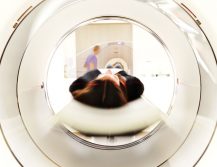
Lumbar discectomy is a type of spine surgery that’s performed on individuals experiencing complications from a herniated or degenerative intervertebral disc. It’s generally performed at an outpatient clinic by a neurosurgeon or orthopedic surgeon, and features high success rates.1 A lumbar discectomy is often recommended when medication, physical therapy and rest aren’t enough to properly heal the area.
Why Have a Lumbar Discectomy?
The lumbar is made up of five bones (or vertebrae) in the lower back. Small, circular cushions, called discs, sit in between each vertebra. Your discs provide your spine with flexibility and shock absorption, so you can sit, bend, run and do any number of other physical movements without painfully grinding the vertebrae or damaging your spinal cord, the nerve inside your spine.
When a disc herniates, or slides away from the vertebrae, it presses against the nerve roots that travel up and down your spinal cord. This causes several different symptoms, including numbness, weakness and pain in the arms, legs and back. For some, these symptoms can be so debilitating they lead to an inability to perform daily tasks like standing or walking, and difficulty controlling their bladder and bowels.
How Does It Work?
A lumbar discectomy is performed to remove sections of the herniated discs that are causing discomfort. The surgery can be done as a traditional open spine surgery, or via a minimally invasive procedure. Depending on the patient’s situation, either a small portion of the disc, an entire disc or more than one disc may be removed to ease nerve pressure. This is referred to as single-level and multi-level surgery, respectively.
Minimally Invasive Spine Surgery
Microdiscectomy – Rather than make a large incision into the back muscles and tissue to reach the disc, the surgeon makes a very small incision in the posterior, usually one to one and a half inches in length, and separates the tissue with a series of dilators. Using fluoroscopic guidance and magnification, the surgeon can see the spine so they can safely and easily remove the herniated portion of the disc.
Post-Op
Since lumbar discectomies are performed on an outpatient basis, patients typically go home the same day after post-op vitals are monitored for about one to three hours. Though most lumbar discectomies have a one to four weeks general recovery time, resuming certain activities, like driving, lifting and going back to work, depend on the patient’s overall physical health and pain tolerance. A medical professional will give you instructions on how to best approach your post-op recovery. In some cases, physical therapy is prescribed to help patients ease back into certain movements.
Are There Risks or Potential Complications?
Just like with any surgical procedure, there are risks involved in lumbar discectomies. Many of the risks and complications, although rare, are associated with the surgery itself:
- Excessive bleeding
- Infection
- Blood clots
- Reactions to anesthesia
Many prospective patients worry their herniated disc(s) or pain will come back after their procedure. Although it could reoccur, it is very uncommon. One study found that only about four percent of patients who underwent a microdiscectomy had complications after a 12-month follow up was performed.2
Professional Spinal Care in the Dallas-Fort Worth Metroplex
If you believe you may be a candidate for lumbar discectomy, you may want to visit a spinal medical professional for proper diagnosis and successful, caring treatment. For those in the North Richland Hills or DFW area, Spine Works Institute, a leader in minimally invasive spine and neck procedures and other advanced treatments, may be able to assist. If you’re in need of relief, contact Spine Works Institute by calling 817-616-0700 or visit us online today to set up an initial appointment!
1 https://www.ncbi.nlm.nih.gov/pmc/articles/PMC2562254/
2 https://www.ncbi.nlm.nih.gov/pmc/articles/PMC3476683/








